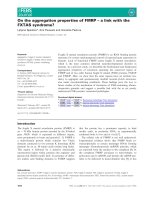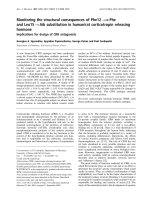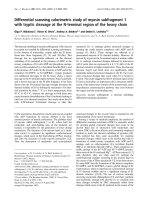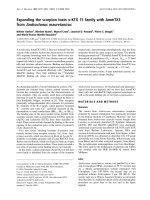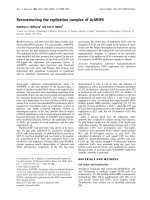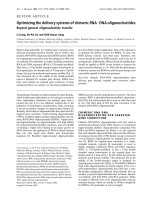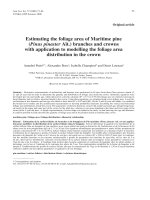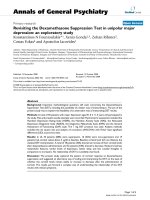Báo cáo y học: "Revisiting the loading dose of amikacin for patients with severe sepsis and septic shock" pptx
Bạn đang xem bản rút gọn của tài liệu. Xem và tải ngay bản đầy đủ của tài liệu tại đây (703.97 KB, 10 trang )
Taccone et al. Critical Care 2010, 14:R53
/>Open Access
RESEARCH
BioMed Central
© 2010 Taccone et al.; licensee BioMed Central Ltd. This is an open access article distributed under the terms of the Creative Commons
Attribution License ( which permits unrestricted use, distribution, and reproduction in
any medium, provided the original work is properly cited.
Research
Revisiting the loading dose of amikacin for patients
with severe sepsis and septic shock
FabioSilvioTaccone
1
, Pierre-François Laterre
2
, Herbert Spapen
3
, Thierry Dugernier
4
, Isabelle Delattre
5
, Brice Layeux
6
,
Daniel De Backer
1
, Xavier Wittebole
2
, Pierre Wallemacq
5
, Jean-Louis Vincent
1
and Frédérique Jacobs*
6
Abstract
Introduction: It has been proposed that doses of amikacin of >15 mg/kg should be used in conditions associated with
an increased volume of distribution (V
d
), such as severe sepsis and septic shock. The primary aim of this study was to
determine whether 25 mg/kg (total body weight) of amikacin is an adequate loading dose for these patients.
Methods: This was an open, prospective, multicenter study in four Belgian intensive care units (ICUs). All consecutive
patients with a diagnosis of severe sepsis or septic shock, in whom amikacin treatment was indicated, were included in
the study.
Results: In 74 patients, serum samples were collected before (t = 0 h) and 1 hour (peak), 1 hour 30 minutes, 4 hours 30
minutes, 8 hours, and 24 hours after the first dose of amikacin. Blood amikacin levels were measured by using a
validated fluorescence polarization immunoassay method, and an open two-compartment model with first-order
elimination was fitted to concentrations-versus-time data for amikacin (WinNonlin). In 52 (70%) patients, peak serum
concentrations were >64 μg/ml, which corresponds to 8 times the clinical minimal inhibitory concentration (MIC)
breakpoints defined by EUCAST for Enterobacteriaceae and Pseudomonas aeruginosa (S<8, R>16 μg/ml). V
d
was 0.41
(0.29 to 0.51) L/kg; elimination half-life, 4.6 (3.2 to 7.8) hours; and total clearance, 1.98 (1.28 to 3.54) ml/min/kg. No
correlation was found between the amikacin peak and any clinical or hemodynamic variable.
Conclusions: As patients with severe sepsis and septic shock have an increased V
d
, a first dose of ≥ 25 mg/kg (total
body weight) of amikacin is required to reach therapeutic peak concentrations. However, even with this higher
amikacin dose, the peak concentration remained below therapeutic target levels in about one third of these patients.
Optimizing aminoglycoside therapy should be achieved by tight serum-concentration monitoring because of the
wide interindividual variability of pharmacokinetic abnormalities.
Introduction
Severe sepsis and septic shock are major causes of mor-
bidity and mortality in intensive care units (ICUs) [1].
Early and appropriate infection control is a priority in the
management of sepsis and requires adequate early
administration of effective antibiotics with a dosing strat-
egy able to achieve therapeutic concentrations at the site
of infection [2,3].
Aminoglycosides are often given as part of empiric
therapy for severe sepsis and septic shock, especially if
Pseudomonas aeruginosa infection is suspected. Their
use is further supported by the emergence of multidrug-
resistant bacteria and the lack of new drugs active against
these microorganisms [4]. Amikacin is a highly potent,
broad-spectrum aminoglycoside that is usually given in
association with β-lactams for the treatment of severe
gram-negative infections [5]. Meta-analyses have shown
limited and conflicting benefits from this combination
therapy [6,7]. However, the paucity of trials including
patients with severe sepsis and septic shock precludes any
recommendations in this setting, and the different amika-
cin doses and regimens used may have led to inadequate
drug concentrations.
In clinical practice, the ratio between the peak and the
minimum inhibitory concentration (MIC) of the caus-
ative gram-negative pathogen (peak/MIC) is considered
* Correspondence:
6
Department of Infectious Diseases, Erasme Hospital, Université Libre de
Bruxelles, Route de Lennik 808, 1070 Bruxelles, Belgium
Full list of author information is available at the end of the article
Taccone et al. Critical Care 2010, 14:R53
/>Page 2 of 10
to be the parameter that best characterizes the in vivo
exposure of the pathogen to serum aminoglycoside con-
centrations [8,9]. Optimal antibacterial activity is
achieved when the peak is 8 to 10 times greater than the
MIC [10-12]. Despite a large variance in MIC values for
different bacteria, therapy should usually target problem-
atic pathogens in ICU patients, such as Enterobacteri-
aceae and Pseudomonas aeruginosa. The clinical MIC
breakpoint for these pathogens is 8 μg/ml [13], indicating
that to optimize the antibacterial activity of amikacin,
peak drug concentrations should reach ≥ 64 μg/ml. This
strategy would allow these "difficult-to-treat" pathogens
to be exposed to bactericidal drug concentrations, even
when treatment is initiated empirically without any
knowledge of specific MICs.
Although aminoglycoside pharmacokinetics (PKs) have
been already described for the treatment of ICU infec-
tions, studies on optimal regimens in sepsis patients had
several limiting factors [14-18]. Few prospective data are
available regarding which aminoglycoside dose should be
used to optimize aminoglycoside concentrations in ICU
patients with severe sepsis and septic shock with multiple
organ dysfunction. Also, no data are available about the
impact of using ideal body weight (IBW) or total body
weight (TBW) on the achievement of optimal peak ami-
kacin concentrations in ICU patients.
The primary aim of this study was to validate a higher
dosing regimen for amikacin in patients with severe sep-
sis and septic shock. We also evaluated the impact of
body weight, and specifically of an IBW-compared with a
TBW-based regimen, on the optimization of peak amika-
cin concentrations. Finally, we evaluated whether partic-
ular clinical or hemodynamic parameters influenced
amikacin PK and propose new recommendations for the
loading dose of amikacin in this critically ill population.
Materials and methods
Study design, patients, and antibiotic treatment
This was an open, prospective, multicenter, noncompara-
tive study performed in four polyvalent ICUs from four
Belgian hospitals between January 2005 and June 2006.
The study protocol was approved by the Ethics Commit-
tees of the different hospitals. Written informed consent
was obtained from each patient or his or her legal guard-
ian. Patients with a diagnosis of severe sepsis or septic
shock according to standard criteria [19], in whom ami-
kacin treatment was indicated, were consecutively
enrolled in the study. The aminoglycoside was given in
combination with a broad-spectrum β-lactam (ceftazi-
dime, cefepime, piperacillin-tazobactam, or meropenem),
according to local clinical practice. Exclusion criteria
were younger than 18 years of age, pregnancy, burns or
cystic fibrosis (because of increased V
d
), neuromuscular
disease, body mass index (BMI) >40 kg/m
2
, chronic renal
failure requiring dialysis, amikacin treatment in the pre-
vious 2 weeks, and known allergy to aminoglycosides. No
patient was included more than once. The study period
was limited to the first 24 hours of treatment.
All patients included in the study received a loading
dose of 25 mg/kg of amikacin based on TBW; this regi-
men was defined for an expected mean V
d
of 0.4 L/kg and
a target peak of 64 μg/ml [17,20,21]. Doses were rounded
off at multiples of 125 mg. The drug was administered
over a 30-min period by using an infusion pump, and the
tubing was flushed with 0.9% sodium chloride after the
dose was administered. Blood samples for drug assays
were taken immediately before administration (0 h) and 1
h, 1 h 30, 4 h 30, 8 h, and 24 h thereafter. These blood-
sampling time points are supposed to belong to the elimi-
nation phase of the drug. The exact time of sampling was
recorded. Blood was collected in a 5-ml plain tube (with-
out anticoagulant). When a clot had completely formed
(15 to 30 min), the sample was centrifuged at 4°C, and the
serum was stored at - 80°C until analysis.
Analytic method for amikacin
Amikacin concentrations were quantified at the end of
the study in a central reference laboratory (St-Luc Hospi-
tal) by using a validated fluorescence polarization immu-
noassay with the TDx analyzer (Abbott Laboratories,
Abbott Park, IL, USA). Routine daily quality controls (5,
15, and 30 μg/ml) and calibrators (3, 10, 20, 35, and 50 μg/
ml) were provided by Abbott Laboratories. No sample
preparation was required for the assay. According to the
manufacturer, the limit of quantification (LOQ) is 0.8 μg/
ml.
PK analysis
Serum amikacin concentrations were analyzed by using
WinNonlin Pharsight Professional Software Version 5.0.1
(Pharsight Corporation, Mountain View, CA, USA). One-
compartment and two-compartment open models with
first-order elimination were compared to fit amikacin
PKs data. A two-compartment model was selected as the
best to fit the Concentration-versus-Time data for amika-
cin (data not shown). The following pharmacokinetic
variables were calculated for each patient: the volume of
distribution in the central (V
d1
) and in the peripheral
(V
d2
) compartments, total volume of distribution (V
ss
),
total clearance (CL), elimination half-life (t
1/2
), area under
the curve (AUC) during the 24 hours, C
max
(maximal con-
centration calculated by extrapolation of the distribution
phase,) and C
min
(concentration 24 h after the start of
infusion).
Taccone et al. Critical Care 2010, 14:R53
/>Page 3 of 10
PK end points
Amikacin levels measured 1 hour (= peak) after the onset
of perfusion [8-11,15,21] were considered the target con-
centrations. Optimal peak was considered as >64 μg/ml.
The potential toxicity threshold of the drug was deter-
mined by a C
min
>5 μg/ml [15,16]. However, no evaluation
of changes in renal function was performed after the first
day of therapy.
Weight estimation
Body weight was considered on the day of amikacin
administration. TBW was taken from medical files for
patients admitted from the floor or the operating room;
in case of admission through the Emergency Department,
institutional databases with recent hospitalizations were
used. TBW was also asked directly of the patients, when-
ever possible. TBW was estimated by doctors and nurses
in 10 patients. IBW was calculated according to Devine's
formula [22]. Corrected body weight (DW) for patients
with BMI <20 and >28 kg/m
2
was calculated according to
previous recommendations [23-25]: for BMI >28 kg/m
2
,
DW = 0.4 × (TBW - IBW) + IBW; for BMI <20 kg/m
2
,
DW = 1.13 × IBW. By using the same PK model obtained
with a TBW-based regimen, simulations of individual PK
profiles were performed to assess the effect of IBW- and
DW-based regimens on peak and C
min
concentrations.
Data collection
Demographic data, comorbidities, and admission diagno-
ses were collected in all patients. Disease severity was
characterized by the Acute Physiology and Chronic
Health Evaluation (APACHE) II score [26]. Organ dys-
function was assessed by using the Sequential Organ Fail-
ure Assessment (SOFA) score [27] on the first day of
antibiotic treatment. Positive microbiologic cultures were
recorded. Site of infection was defined according to the
Centers for Disease Control definitions [28]. Biologic
data, including coagulation parameters, complete blood
count, electrolyte, urea, creatinine, bilirubin, total protein
and albumin concentrations, myocardial and liver
enzymes, and C-reactive protein (CRP) concentrations,
were recorded at inclusion and at 24 hours. Creatinine
clearance (CrCl) was estimated with the Cockcroft and
Gault equation by using TBW [29]. Renal dysfunction
was considered when CrCl was <50 ml/min [30]. Acute
renal failure was defined as a renal SOFA score >2 (creati-
nine > 3.0 mg/dl and/or urine output <500 ml/day) and/
or need for renal replacement therapy [27]. Other
recorded parameters were the use of adrenergic drugs,
mechanical ventilation, renal support, 24-hour fluid bal-
ance, length of ICU stay, ICU mortality, and cause of
death. Hemodynamic and blood-gas analysis data were
collected at baseline and 8 and 24 hours after the start of
the protocol.
Statistical analysis
Statistical analyses were performed by using the SPSS
13.0 for the Windows NT software package (SPSS Inc.
2004). Descriptive statistics were computed for all study
variables. A Kolmogorov-Smirnov test was used, and his-
tograms and normal-quantile plots were examined to ver-
ify the normality of distribution of continuous variables.
Discrete variables were expressed as counts (percentage),
and continuous variables, as mean ± SD or median [25th-
75th percentiles]. Demographics and clinical differences
between study groups were assessed by using a χ
2
,
Fisher's Exact test, Student's t test, or Mann-Whitney U
test, as appropriate. The Pearson's (r) correlation coeffi-
cient was used to determine linear correlation. Associa-
tion between variables was tested by simple regression
analysis and coefficient of determination (R
2
) in the case
of nonlinear correlation. An univariate analysis followed
by a multivariate stepwise linear-regression analysis,
including all the collected variables, was also performed
to predict the amikacin peak. A value of P < 0.05 was con-
sidered to be statistically significant.
Results
Characteristics of patients
We enrolled 74 patients (Table 1). The median APACHE
II score was 21, and the median SOFA score on admission
was 8. Fifty-six (76%) patients were treated with mechan-
ical ventilation, and 20 (27%) patients had acute renal fail-
ure. Overall ICU mortality was 36%; 22 of 27 deaths were
attributed to sepsis or related multiple organ failure.
Most infections were respiratory or abdominal and were
microbiologically documented in 50 (68%) patients.
Blood cultures were positive in 29 (39%) patients. Forty-
three (58%) cases of sepsis were secondary to gram-nega-
tive bacilli, with 28 infections due to difficult-to-treat
pathogens (P. aeruginosa (n = 15); Enterobacter spp. (n =
8); Serratia marcescens (n = 2); Citrobacter freundii, Haf-
nia alvei, or Morganella morganii (each n = 1)).
Pharmacokinetic data
The median amikacin dose was 1,750 mg (range, 1,125 to
3,000 mg). Main PK parameters for amikacin were V
ss
0.41 [0.29 to 0.51] L/kg, t
1/2
4.6 [3.2 to 7.8] hours, and CL
1.98 [1.28-3.54] ml/min/kg (Table 2). Median serum con-
centrations of amikacin were 0, 72.7 (61.7 to 90.2), 61.5
(48.5 to 73.1), 37.3 (27.7 to 46.5), 26.7 (16.4 to 33.8), and
6.7 (2.1 to 15.4) μg/ml at 0 hours, 1 hour (peak), 1 hour 30
minutes, 4 hours 30 minutes, 8 hours, and 24 hours,
respectively (Figure 1). Peak serum concentrations were
>64 μg/ml in 52 (70%) patients (Figure 2). For a target
MIC of 8 μg/ml, the peak/MIC ratio was 9.6 ± 3.5. With
this regimen, peak/MIC >8 would have been reached in
all patients for an MIC of ≤ 4 μg/ml.
Taccone et al. Critical Care 2010, 14:R53
/>Page 4 of 10
Thirty-nine (52%) patients had a C
min
>5 μg/ml. C
min
(R
2
= 0.51, P < 0.01) and CL (R
2
= 0.41; P <0.01), but not
peak concentration, were correlated with CrCl at inclu-
sion. Moreover, patients with renal dysfunction had
higher amikacin levels at 4 hours 30 minutes (43.9 ± 11.5
μg/ml vs. 31.8 ± 14.4 μg/ml; P < 0.001) and 24 h (15.4 (8.0
to 21.4) μg/ml vs. 2.6 (1.3 to 6.0) μg/ml; P < 0.001), as well
as lower CL and increased t
1/2
and AUC, than had
patients with normal renal function. However, the V
ss
and
peak concentrations were similar (Table 2).
Impact of weight on peak amikacin concentrations
Adequate peak concentrations were achieved in six (54%)
of 11 patients with a BMI <20, 23 (64%) of 36 with a BMI
of 20 to 25, 15 (83%) of 18 with a BMI from 25 to 30, and
eight (89%) of nine with a BMI >30. Simulation with
doses calculated by using the IBW showed that only 35
(47%) patients would have reached a peak >64 μg/ml (P <
0.01 compared with a regimen established by using
TBW). The use of DW compared with TBW for dose cal-
culation had no effect in terms of adequate peak concen-
trations (Table 3). When the amikacin dose was
calculated by using DW, a dose of 28 mg/kg would have
been necessary for 70% of patients to have achieved the
desired peak concentration.
Simulations with other regimens
By using a simulated amikacin dose of 15 mg/kg, we
observed that only seven (9%) patients would have
reached a peak concentration >64 μg/ml (P < 0.001 vs. 25
mg/kg TBW dose), whereas for a 30-mg/kg regimen, 80%
of patients would have achieved the optimal peak concen-
tration (Table 3). Interestingly, the proportion of patients
with a C
min
>5 μg/ml would have been similar to the 15
and 25 mg/kg regimens (39% vs. 52%; P = 0.1).
Correlation with clinical variables
The peak of amikacin was not correlated with or pre-
dicted by any biologic, hemodynamic, or clinical variable,
including age, mechanical ventilation, APACHE II or
SOFA score at admission, presence of shock, maximal
dose of vasopressor agents, fluid balance, or renal failure.
Patients with a peak concentration >64 μg/ml had similar
characteristics to patients with peak concentrations <64
μg/ml (Table 4).
Discussion
This is the first study in which a higher dose of amikacin
was prospectively validated in sepsis patients after a PK
analysis. We showed that, because of PK alterations, a
loading dose of ≥ 25 mg/kg of amikacin is necessary to
achieve therapeutic peak concentrations in patients with
severe sepsis or septic shock. Antimicrobials PKs in ICU
patients are significantly different from those in healthy
Table 1: Patient characteristics, hemodynamic and biologic
data on admission, and fluid balance during the first 24
hours
Variables Values
Age (years) 63 ± 13
Sex (Male/Female) 50/24
Body Mass Index 24.7 ± 4.6
APACHE II score 21 (16-26)
SOFA score on admission 8 (5-11)
Medical/Surgical 50/24
COPD 14 (19%)
Diabetes 17 (23%)
Heart disease 39 (53%)
Chronic renal insufficiency 7 (9%)
Liver cirrhosis 11 (15%)
Immunosuppressive drugs 25 (34%)
Malignancy 24 (32%)
Community/hospital-acquired infections 22/52
Severe sepsis/septic shock 17/56
Mechanical ventilation 56 (76%)
Acute renal failure 20 (27%)
Vasopressor agents 56 (76%)
ICU stay (days) 14 (5-25)
Overall ICU mortality 27 (37%)
Mean arterial pressure (mmHg) 70 ± 14
Central venous pressure (mmHg) 10 ± 5
pH 7.41 ± 0.12
PaO
2
/FiO
2
ratio 166 [112-227]
PaCO
2
(mmHg) 39 ± 12
Lactate (mEq/L) 2.7 [1.7-3.9]
White blood cells (/mm
3
) 11400 [8600-20400]
Hematocrit (%) 30.4 ± 7.6
Platelets (10
3
/mm
3
) 175 [86-292]
Bilirubin (mg/dl) 0.9 [0.5-2.0]
Creatinine (mg/dl) 1.7 [1.1-3.1]
C-reactive protein (mg/dl) 17 [10-26]
Creatinine clearance (ml/min) 54 [33-86]
Fluid balance (ml/24 h) 2650 ± 2121
Fluids IN (ml/24 h) 4594 ± 1892
Fluids OUT (ml/24 h) 1944 ± 1621
Data are expressed as counts (percentage), median (IQR), or mean ±
SD. APACHE, Acute Physiology and Chronic Health Evaluation; COPD,
chronic obstructive pulmonary disease; ICU, intensive care unit;
SOFA, Sequential Organ Failure Assessment.
Taccone et al. Critical Care 2010, 14:R53
/>Page 5 of 10
volunteers or less severely ill patients [14,31,32].
Increased cardiac index and interstitial fluid shifts in sep-
sis result in a larger volume of distribution (V
d
), which
may reduce plasma antibiotic levels [33]. Decreased pro-
tein binding can result in higher free-drug concentra-
tions, and organ dysfunction may decrease drug
metabolism and clearance [33]. Finally, infections, espe-
cially when acquired in the ICU, are often caused by
more-resistant pathogens [34]. For aminoglycosides, peak
concentration is determined by the administered dose
and by the V
d
[30]. The V
d
of amikacin is between 0.2 and
0.3 L/kg in healthy volunteers and in patients with mild
infections [12,20,35]. In our study, the median V
d
was
0.41 L/kg, corresponding to a >60% increase when com-
pared with normal ranges. These results confirm data
from previous studies. In 200 adult and pediatric ICU
patients with severe gram-negative infections, the V
d
of
amikacin varied from 0.17 to 0.98 L/kg, with a mean of
0.37 L/Kg [16]. A mean V
d
of 0.47 L/kg was reported in 30
ICU patients [17]. In patients with postoperative septic
shock, the V
d
was 0.41 ± 0.08 L/kg, a significantly higher
value than that in controls (0.25 ± 0.01 L/kg) [36]. The
variability of V
d
in sepsis patients is probably multifacto-
rial and depends on the degree of inflammation, vascular
permeability, and fluid extravasation [12,32,37]. Doses of
15 and 20 mg/kg produced means of 33.5 ± 14.8 and 33.8
± 4.7 μg/ml, respectively, in adult ICU patients [15,16].
However, the peak obtained with these regimens was
largely below the desired concentration of 64 μg/ml, sug-
gesting that higher doses of amikacin should be adminis-
tered to achieve optimal peak levels. Moreover, previous
studies on amikacin dose in ICU patients had limited
patient samples [17,36,38], were retrospective [10,39], or
had exclusion criteria, such as septic shock [15],
APACHE II score >35 [40], liver cirrhosis [17], or acute
renal failure [15-17,40], making it difficult to extrapolate
the results to a general septic ICU population.
Our study is the first to provide data on sepsis patients
with several comorbidities, high disease severity, and
multiple organ dysfunctions, with an ICU mortality rate
Figure 1 Pharmacokinetic profile of amikacin. Dashed line, peak of 64 μg/ml corresponding to 8 times the clinical breakpoint of the minimal in-
hibitory concentration (MIC = 8 μg/ml, solid line) for gram-negative bacteria.
Taccone et al. Critical Care 2010, 14:R53
/>Page 6 of 10
of nearly 40%. This cohort of 74 patients was relatively
large and representative of a typical ICU population.
Most of the infections were secondary to gram-negative
infections, with 20% being caused by difficult-to-treat
bacteria known to be associated with high mortality rates
[41]. This represents the population in which aminogly-
coside treatment could be recommended [6].
Assuming a three- to fourfold factor for converting
doses of amikacin to gentamicin and tobramycin, it has
been suggested that higher doses should be used for these
two aminoglycosides in patients with septic shock
Figure 2 Distribution of peak concentrations. Black bars, peak >64 μg/ml; gray bars, peak <64 μg/ml.
Table 2: Amikacin pharmacokinetics in patients with or without renal dysfunction
All
(n = 74)
CrCl <50 ml/min
(n = 38)
CrCl >50 ml/min
(n = 36)
V
d1
(central) (L) 0.23 (0.18-0.28) 0.23 (0.19-0.35) 0.22 (0.17-0.26)
V
d2
(peripheral) (L) 0.18 (0.11-0.23) 0.19 (0.12-0.29) 0.18 (0.11-0.23)
V
ss
(L/kg) 0.41 (0.29-0.51) 0.42 (0.31-0.54) 0.40 (0.28-0.49)
t
1/2
(hours) 4.6 (3.2-7.8) 7.6 (4.6-13.2) 3.3 (2.5-4.6)
a
CL (ml/min/kg) 1.98 (1.28-3.54) 1.29 (0.84-2.01) 3.49 (1.94-5.04)
a
AUC (mg × h/ml) 798 (478-1285) 1,177 (833-1961) 466 (368-763)
a
C
max
(μg/ml) 91.7 (73.1-112.8) 91.0 (70.6-112.8) 92.3 (74.1-109.4)
Peak (μg/ml) 72.7 (61.7-90.2) 71.5 (57.3-86.3) 75.7 (63.1-92.9)
C
min
(μg/ml) 6.7 (2.1-15.4) 15.4 (8.0-21.4) 2.6 (1.3-6.0)
a
Data are expressed as median (IQR).
a
p < 0.001. AUC, area under the curve; t
1/2
, elimination half-time; CL, clearance; CrCl, creatinine clearance;
V
d
, volume of distribution; V
ss
, total volume of distribution.
Taccone et al. Critical Care 2010, 14:R53
/>Page 7 of 10
[18,42]. However, a dose >7 mg/kg has not been prospec-
tively validated for these drugs. Our data demonstrate
that, with 25 mg/kg of amikacin, the target peak concen-
tration (>64 μg/ml) was achieved in 70% of patients. An
even higher dose may be necessary in some patients for
whom the peak concentration remains below the desired
level. Simulation with a standard regimen (15 mg/kg) of
amikacin resulted in insufficient peak concentrations in
>90% of patients, confirming the need to increase amika-
cin doses to ensure that adequate peak levels are achieved
in sepsis patients.
A relation between the intensity of the septic process
and the expansion of the V
d
can be assumed. Marik et al.
[16,43] and Lugo-Goytia et al. [39] demonstrated an asso-
ciation between sepsis severity, estimated by the
APACHE II score, and aminoglycoside V
d
. V
d
was also
reported to be correlated with oxygen extraction ratio,
serum albumin levels, and adrenergic support in another
study [17]. We did not find any relation between V
d
and
any demographic, clinical, hemodynamic, or biologic
variable. Our population was analyzed in the early phase
of the septic process, and this may explain the difference
from previous studies, which were conducted in the
steady state. The considerable interindividual variability
observed in critically ill patients may also limit the a pri-
ori prediction of PK abnormalities and the optimal dose
that should be administered to sepsis patients. Optimiz-
ing aminoglycoside therapy should, therefore, be
achieved by tight serum-concentration monitoring (peak
and trough) and rapid dose adjustment [44] according to
pathogen MIC. This strategy requires pathogen MIC
Table 3: Differences in numbers of patients achieving optimal peak or high C
min
concentrations
Regimen Peak >64 μg/ml
n (%)
C
min
>5 μg/ml
n (%)
15 mg/kg TBW 7 (9) 29 (39)
25 mg/kg TBW 50 (72) 39 (52)
30 mg/kg TBW 59 (79) 43 (58)
25 mg/kg IBW 35 (47) 39 (52)
25 mg/kg DW 42 (56) 39 (52)
Doses were calculated by using total body weight (TBW), ideal body weight (IBW), or IBW with correction factors (DW) for extreme body mass
indexes.
Table 4: Differences between patients with optimal (>64 μg/ml) and inadequate (<64 μg/ml) peak amikacin
concentrations
Peak >64
(n = 52)
Peak <64
(n = 22)
Male 32 (62) 18 (81)
Nosocomial infections 37 (71) 15 (68)
Medical admission 37 (71) 13 (59)
Positive blood cultures 18 (35) 11 (50)
Shock/vasopressors 40 (76) 16 (72)
Mechanical ventilation 37 (71) 19 (86)
Age (years) 62 ± 14 64 ± 13
APACHE II score 20 (16-25) 23 (16-28)
SOFA score 8 (5-10) 9 (5-11)
Highest lactate (mmol/L) 3.1 (1.5-4.8) 2.8 (1.3-5.2)
Creatinine (mg/ml) 1.6 ± 1.1 1.7 ± 1.3
Albumin (g/dl) 2.4 ± 0.8 2.4 ± 0.8
Fluid balance (ml/24 h) 2,589 ± 2,153 2,793 ± 2,085
Data are expressed as median (IQR), mean (± SD), or counts (percentage). APACHE, Acute Physiology and Chronic Health Evaluation; SOFA,
Sequential Organ Failure Assessment.
Taccone et al. Critical Care 2010, 14:R53
/>Page 8 of 10
measurement and a C
min
<5 μg/ml to optimize the subse-
quent doses and to avoid drug accumulation.
Physiologic alterations associated with increased BMI
affect the aminoglycoside PK. This is due to the variable
penetration of these drugs into adipose tissue. Previous
studies have validated dosing weight correction factors to
normalize predictions of V
ss
in morbidly obese subjects
[23] as well as in overweight/underweight patients [24] in
a non-ICU population. Also, IBW seems to fit the phar-
macokinetics of these antimicrobials better than the total
body weight (TBW) to calculate the aminoglycoside regi-
men [45,46]; however, some uncertainty exists in this area
[47]. Our results suggest that using a DW-based regimen
could result in a relative underdosing of aminoglycoside
in critically ill sepsis patients when compared with a
TBW-based regimen. Thus, if using IBW, a loading dose
even higher than 25 mg/kg should be considered in this
patient population to obtain adequate amikacin peak
concentrations. Importantly, a higher dosage should be
considered also in patients with a BMI <20 to avoid
underdosage. We excluded morbidly obese patients (BMI
>40), so that we cannot comment on this particular popu-
lation.
Our study has some limitations. First, we evaluated the
PK profile of amikacin only during the first 24 hours of
administration, and thus cannot make any statement with
regard to subsequent doses. The V
d
may decrease during
therapy when capillary leakage subsides and sepsis
resolves [48]. In these circumstances, amikacin doses <25
mg/kg may be sufficient to achieve therapeutic concen-
trations.
Second, a control group of patients without sepsis was
not included. However, it would have been unethical to
expose nonseptic patients, even with increased V
d
, such
as in trauma or cardiac surgery [5,49], to a higher dose of
a potentially toxic antibiotic drug.
Third, we did not evaluate the evolution of renal func-
tion in our population, with amikacin concentrations
exceeding the toxicity limit at 24 hours in >50% of
patients. However, targeting peak amikacin concentra-
tions >60 μg/ml resulted in the same incidence of nephro-
toxicity compared with conventional treatment [40], as
long as individualized pharmacokinetic dosing of amino-
glycoside was performed to allow a necessary drug-free
period. The CrCl was estimated by using the Crockroft
and Gault formula; however, this may overestimate CrCl
because immobility and reduced muscle mass in ICU
patients and a more accurate assessment of renal function
should have been based on the urinary creatinine excre-
tion [50]. Fourth, we lack information about the clinical
and microbiologic response, and follow-up was not con-
tinued after ICU discharge, as this was not the primary
aim of the study. Clearly, a systematic clinical PK study is
required to evaluate the beneficial effects of this strategy
on the outcome of sepsis patients.
Finally, we did not directly measure the body weight,
and inaccurate weight estimation may have occurred for
some of the studied patients [51].
Conclusions
Patients with severe sepsis and septic shock have an
increased V
d
necessitating an initial dose of ≥ 25 mg/kg
TBW of amikacin to reach therapeutic peak concentra-
tions. Even this regimen resulted in serum concentrations
that were too low in one third of our patients. If using
DW when calculating amikacin dose, an even higher dose
should probably be considered to achieve adequate peak
concentrations. The large interindividual PK variability
and high amikacin concentrations at 24 hours in patients
with renal impairment support the need for monitoring
of serum amikacin concentrations in sepsis patients, to
optimize peak concentrations, and to prevent, by increas-
ing the dose interval, the potential toxicity of persistently
high serum concentrations. It would seem important to
evaluate whether this strategy could be beneficial in
terms of clinical efficacy and toxicity in the sepsis popula-
tion.
Key messages
• A loading dose of ≥ 25 mg/kg TBW of amikacin is
necessary to optimize peak concentrations and
increase the bactericidal activity of the drug in
patients with severe sepsis and septic shock
• An even higher dosage may be necessary if amikacin
regimen is calculated by using DW or in underweight
patients (BMI <20) to avoid underdosage
• Therapeutic drug monitoring is mandatory, as no
clinical or biologic variable can predict amikacin
pharmacokinetics in this population
Abbreviations
APACHE: Acute Physiology and Chronic Health Evaluation; AUC: area under the
curve; BMI: body mass index; CL: clearance; CrCl: creatinine clearance; CRP: C-
reactive protein; DW: corrected body weight; IBW: ideal body weight; MIC: min-
imum inhibitory concentration; PK: pharmacokinetic; SOFA: sequential organ
failure assessment; TBW: total body weight; V
d
: volume of distribution; V
ss
: total
volume of distribution.
Competing interests
The authors declare that they have no competing interests.
Authors' contributions
FJ conceived the study protocol. FST, FJ, PFL, TD, and HS participated in the
design and coordination of the study. FST, JLV, and FJ drafted the present man-
uscript. All authors read and approved the final manuscript.
Acknowledgements
We thank all the nurses and doctors who contributed to this study. The study
was supported by grants from AstraZeneca, Wyeth Pharmaceuticals, GlaxoS-
mithKline Pharmaceuticals, and Bristol-Myers Squibb.
Taccone et al. Critical Care 2010, 14:R53
/>Page 9 of 10
Author Details
1
Department of Intensive Care, Erasme Hospital, Université Libre de Bruxelles,
Route de Lennik 808, 1070 Bruxelles, Belgium,
2
Department of Intensive Care,
Cliniques Universitaires St-Luc Avenue Hippocrate 10, 1200 Bruxelles, Belgium,
3
Department of Intensive Care, Universitair Ziekenhuis Brussel, Laerbeeklaan
101, 1090 Bruxelles, Belgium,
4
Department of Intensive Care, St-Pierre Hospital,
Avenue Reine Fabiola 9, 1340 Ottignies, Belgium,
5
Department of Clinical
Biochemistry and Pharmacokinetics, Cliniques Universitaires, St-Luc Avenue
Hippocrate 10, 1200 Bruxelles, Belgium and
6
Department of Infectious
Diseases, Erasme Hospital, Université Libre de Bruxelles, Route de Lennik 808,
1070 Bruxelles, Belgium
References
1. Vincent JL, Taccone F, Schmit X: Classification, incidence, and outcomes
of sepsis and multiple organ failure. Contrib Nephrol 2007, 156:64-74.
2. Kollef MH, Sherman G, Ward S, Fraser VJ: Inadequate antimicrobial
treatment of infections: a risk factor for hospital mortality among
critically ill patients. Chest 1999, 115:462-474.
3. Zaragoza R, Artero A, Camarena JJ, Sancho S, Gonzalez R, Nogueira JM:
The influence of inadequate empirical antimicrobial treatment on
patients with bloodstream infections in an intensive care unit. Clin
Microbiol Infect 2003, 9:412-418.
4. Falagas ME, Kopterides P: Old antibiotics for infections in critically ill
patients. Curr Opin Crit Care 2007, 13:592-597.
5. Bochud PY, Glauser MP, Carlet J, Calandra T: Empirical antibiotic therapy
for patients with severe sepsis and septic shock. In The Sepsis Text
Edited by: Vincent JL, Carlet J, Opal SM. Norwell: Kluwer Academic;
2002:539-558.
6. Safdar N, Handelsman J, Maki DG: Does combination antimicrobial
therapy reduce mortality in gram-negative bacteraemia? A meta-
analysis. Lancet Infect Dis 2004, 4:519-527.
7. Paul M, Silbiger I, Grozinsky S, Soares-Weiser K, Leibovici L: Beta lactam
antibiotic monotherapy versus beta lactam-aminoglycoside antibiotic
combination therapy for sepsis. Cochrane Database Syst Rev
2006:CD003344.
8. Moore RD, Smith CR, Lietman PS: The association of aminoglycoside
plasma levels with mortality in patients with gram-negative
bacteremia. J Infect Dis 1984, 149:443-448.
9. Moore RD, Smith CR, Lietman PS: Association of aminoglycoside plasma
levels with therapeutic outcome in gram-negative pneumonia. Am J
Med 1984, 77:657-662.
10. Moore RD, Lietman PS, Smith CR: Clinical response to aminoglycoside
therapy: importance of the ratio of peak concentration to minimal
inhibitory concentration. J Infect Dis 1987, 155:93-99.
11. Deziel-Evans LM, Murphy JE, Job ML: Correlation of pharmacokinetic
indices with therapeutic outcome in patients receiving
aminoglycosides. Clin Pharm 1986, 5:319-324.
12. Pinder M, Bellomo R, Lipman J: Pharmacological principles of antibiotic
prescription in the critically ill. Anaesth Intensive Care 2002, 30:134-144.
13. EUCAST: Aminoglycosides: EUCAST clinical MIC breakpoints. [http://
wwwsrgaorg/eucastwt/MICTAB/MICaminoglycosideshtml].
14. Fukuoka N, Aibiki M: Recommended dose of arbekacin, an
aminoglycoside against methicillin-resistant Staphylococcus aureus,
does not achieve desired serum concentration in critically ill patients
with lowered creatinine clearance. J Clin Pharm Ther 2008, 33:521-527.
15. Beaucaire G, Leroy O, Beuscart C, Karp P, Chidiac C, Caillaux M: Clinical
and bacteriological efficacy, and practical aspects of amikacin given
once daily for severe infections. J Antimicrob Chemother 1991, 27(Suppl
C):91-103.
16. Marik PE, Havlik I, Monteagudo FS, Lipman J: The pharmacokinetic of
amikacin in critically ill adult and paediatric patients: comparison of
once-versus twice-daily dosing regimens. J Antimicrob Chemother 1991,
27(Suppl C):81-89.
17. Lugo G, Castaneda-Hernandez G: Relationship between hemodynamic
and vital support measures and pharmacokinetic variability of
amikacin in critically ill patients with sepsis. Crit Care Med 1997,
25:806-811.
18. Rea RS, Capitano B, Bies R, Bigos KL, Smith R, Lee H: Suboptimal
aminoglycoside dosing in critically ill patients. Ther Drug Monit 2008,
30:674-681.
19. Levy MM, Fink MP, Marshall JC, Abraham E, Angus D, Cook D, Cohen J,
Opal SM, Vincent JL, Ramsay G: 2001 SCCM/ESICM/ACCP/ATS/SIS
International Sepsis Definitions Conference. Crit Care Med 2003,
31:1250-1256.
20. Gilbert DN: Aminoglycosides. In Principle and Practice in Infectious
Diseases Edited by: Mandell GL, Bennett JE, Dolin R. New York: Churchill
Livingstone; 2000:307-336.
21. Kashuba AD, Nafziger AN, Drusano GL, Bertino JS Jr: Optimizing
aminoglycoside therapy for nosocomial pneumonia caused by gram-
negative bacteria. Antimicrob Agents Chemother 1999, 43:623-629.
22. Devine BJ: Gentamicin therapy. Drug Intel Clin Pharm 1974, 8:650-655.
23. Bauer LA, Blouin RA, Griffen WO Jr, Record KE, Bell RM: Amikacin
pharmacokinetics in morbidly obese patients. Am J Hosp Pharm 1980,
37:519-522.
24. Traynor AM, Nafziger AN, Bertino JS Jr: Aminoglycoside dosing weight
correction factors for patients of various body sizes. Antimicrob Agents
Chemother 1995, 39:545-548.
25. Pai MP, Bearden DT: Antimicrobial dosing considerations in obese adult
patients. Pharmacotherapy 2007, 27:1081-1091.
26. Knaus WA, Draper EA, Wagner DP, Zimmerman JE: APACHE II: A severity
of disease classification system. Crit Care Med 1985, 13:818-829.
27. Vincent JL, Moreno R, Takala J, Willatts S, de Mendonça A, Bruining H,
Reinhart CK, Suter PM, Thijs LG: The SOFA (Sepsis-related Organ Failure
Assessment) score to describe organ dysfunction/failure. Intensive Care
Med 1996, 22:707-710.
28. Horan TC, Andrus M, Dudeck MA: CDC/NHSN surveillance definition of
health care-associated infection and criteria for specific types of
infections in the acute care setting. Am J Infect Control 2008, 36:309-332.
29. Cockcroft DW, Gault MH: Prediction of creatinine clearance from serum
creatinine. Nephron 1976, 16:31-41.
30. Roberts JA, Lipman J: Pharmacokinetic issues for antibiotics in the
critically ill patient. Crit Care Med 2009, 37:840-851.
31. Zaske DE, Sawchuk RJ, Gerding DN, Strate RG: Increased dosage
requirements of gentamicin in burn patients. J Trauma 1976,
16:824-828.
32. Hassan E, Ober JD: Predicted and measured aminoglycoside
pharmacokinetic parameters in critically ill patients. Antimicrob Agents
Chemother 1987, 31:1855-1858.
33. Van Dalen R, Vree TB: Pharmacokinetics of antibiotics in critically ill
patients. Intensive Care Med 1990, 16(Suppl 3):S235-S238.
34. Van Eldere J: Multicentre surveillance of Pseudomonas aeruginosa
susceptibility patterns in nosocomial infections. J Antimicrob
Chemother 2003, 51:347-352.
35. Holford N: Clinical Pharmacokinetics: Drug Data Handbook 3rd edition.
Auckland: Adis; 1998.
36. Oparaoji EC, Cornwell EE III, Hekmat E, Lum CR, Adir JS, Siram S:
Aminoglycoside volume of distribution in postoperative patients with
septic shock. Clin Pharm 1993, 12:131-134.
37. Botha FJ, Bijl P van der, Seifart HI, Parkin DP: Fluctuation of the volume of
distribution of amikacin and its effect on once-daily dosage and
clearance in a seriously ill patient. Intensive Care Med 1996, 22:443-446.
38. Kihara M, Ikeda Y, Takagi N, Fujita H, Shibata K, Masumori S, Shiratori K,
Umemura S, Shionoiri H, Ishii M: Pharmacokinetics of single-dose
intravenous amikacin in critically ill patients undergoing slow
hemodialysis. Intensive Care Med 1995, 21:348-351.
39. Lugo-Goytia G, Castaneda-Hernandez G: Bayesian approach to control
of amikacin serum concentrations in critically ill patients with sepsis.
Ann Pharmacother 2000, 34:1389-1394.
40. Bartal C, Danon A, Schlaeffer F, Reisenberg K, Alkan M, Smoliakov R, Sidi A,
Almog Y: Pharmacokinetic dosing of aminoglycosides: a controlled
trial. Am J Med 2003, 114:194-198.
41. Abbo A, Carmeli Y, Navon-Venezia S, Siegman-Igra Y, Schwaber MJ:
Impact of multi-drug-resistant Acinetobacter baumannii on clinical
outcomes. Eur J Clin Microbiol Infect Dis 2007, 26:793-800.
42. Buijk SE, Mouton JW, Gyssens IC, Verbrugh HA, Bruining HA: Experience
with a once-daily dosing program of aminoglycosides in critically ill
patients. Intensive Care Med 2002, 28:936-942.
43. Marik PE: Aminoglycoside volume of distribution and illness severity in
critically ill septic patients. Anaesth Intensive Care 1993, 21:172-173.
Received: 1 January 2010 Revised: 4 March 2010
Accepted: 6 April 2010 Published: 6 April 2010
This article is available from: 2010 Taccone et al.; licensee BioMed Central Ltd. This is an open access article distributed under the terms of the Creative Commons Attribution License ( which permits unrestricted use, distribution, and reproduction in any medium, provided the original work is properly cited.Critica l Care 2010, 14:R 53
Taccone et al. Critical Care 2010, 14:R53
/>Page 10 of 10
44. Nicolau DP: Optimizing outcomes with antimicrobial therapy through
pharmacodynamic profiling. J Infect Chemother 2003, 9:292-296.
45. Morgan DJ, Bray KM: Lean body mass as a predictor of drug dosage:
implications for drug therapy. Clin Pharmacokinet 1994, 26:292-307.
46. Cheymol G: Effects of obesity on pharmacokinetics implications for
drug therapy. Clin Pharmacokinet 2000, 39:215-231.
47. Bourguignon L, Goutelle S, Gerard C, Guillermet A, Burdin de Saint MJ,
Maire P, Ducher M: [Amikacin pharmacokinetics in adults: a variability
that question the dose calculation based on weight]. Therapie 2009,
64:47-53.
48. Triginer C, Izquierdo I, Fernandez R, Rello J, Torrent J, Benito S, Net A:
Gentamicin volume of distribution in critically ill septic patients.
Intensive Care Med 1990, 16:303-306.
49. Pea F, Viale P, Furlanut M: Antimicrobial therapy in critically ill patients: a
review of pathophysiological conditions responsible for altered
disposition and pharmacokinetic variability. Clin Pharmacokinet 2005,
44:1009-1034.
50. Martin JH, Fay MF, Udy A, Roberts J, Kirkpatrick C, Ungerer J, Lipman J:
Pitfalls of using estimations of glomerular filtration rate in an intensive
care population. Intern Med J 2010 in press.
51. Anglemyer B, Hernandez C, Brice JH, Zou B: The accuracy of visual
estimation of body weight in the ED. Am J Emerg Med 2004, 22:526-529.
doi: 10.1186/cc8945
Cite this article as: Taccone et al., Revisiting the loading dose of amikacin for
patients with severe sepsis and septic shock Critical Care 2010, 14:R53
